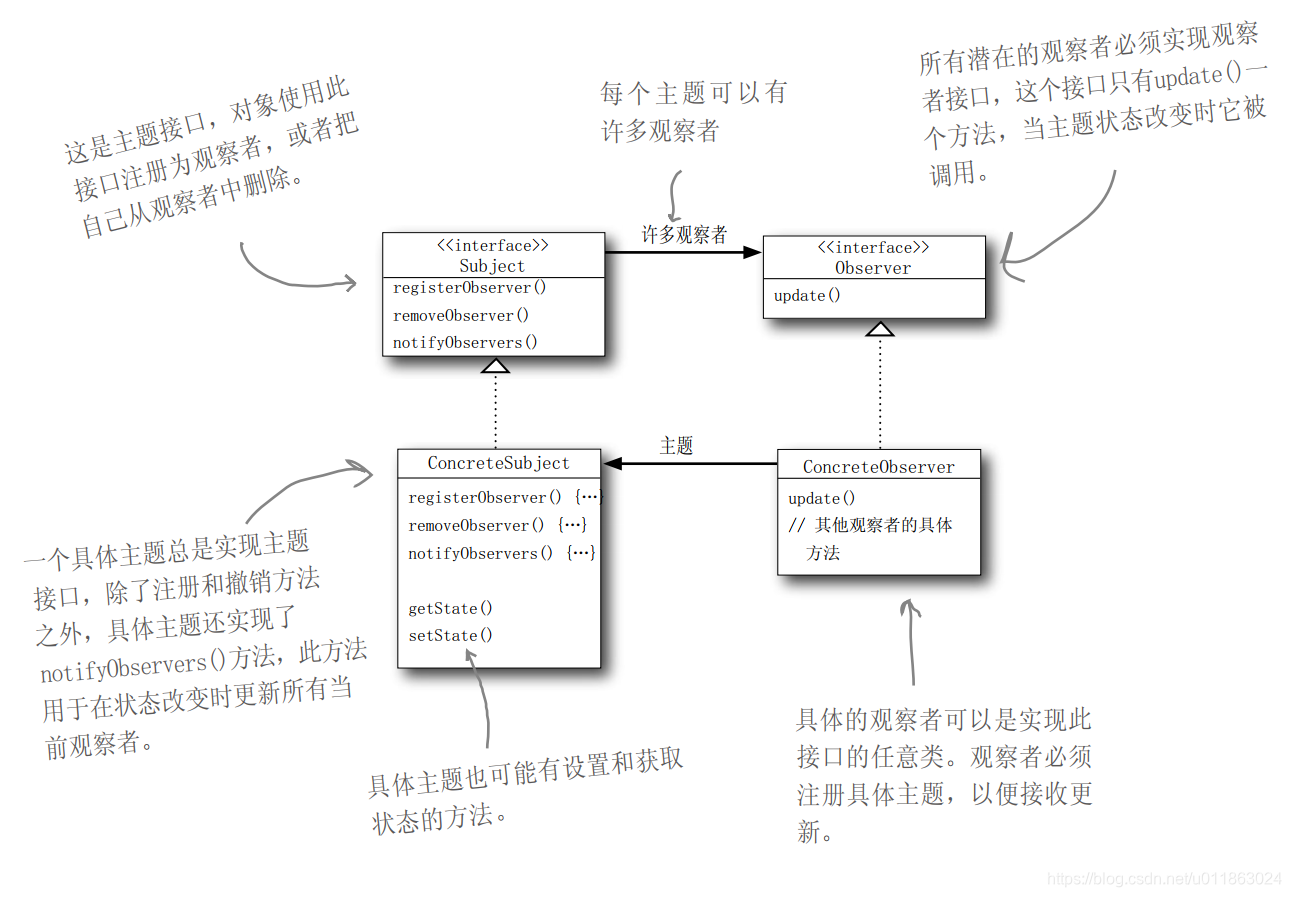定义
观察者(Observer)模式定义了对象之间的一对多依赖,这样一来,当一个对象改变状态时,它的所有依赖者都会收到通知并自动更新。

OO设计原则:为了交互对象之间的松耦合设计而努力。
案例:气象监测应用
概括
此系统中的三个部分是
- 气象站(获取实际气象数据的物理装置)
- WeatherData对象(追踪来自气象站的数据,并更新布告板)
- 布告板(显示目前天气状况给用户看)
WeatherData对象知道如何跟物理气象站联系,以取得更新的数据。
WeatherData对象会随即更新三个布告板的显示:
- 目前状况(温度、湿度、气压)、
- 气象统计
- 天气预报。
目标是建立一个应用,利用WeatherData对象取得数据,并更新三个布告板:目前状况、气象统计和天气预报 。

设计图

放码过来
气象站主程序
public class WeatherStation {public static void main(String[] args) {WeatherData weatherData = new WeatherData();CurrentConditionsDisplay currentDisplay = new CurrentConditionsDisplay(weatherData);StatisticsDisplay statisticsDisplay = new StatisticsDisplay(weatherData);ForecastDisplay forecastDisplay = new ForecastDisplay(weatherData);weatherData.setMeasurements(80, 65, 30.4f);System.out.println("---");weatherData.setMeasurements(82, 70, 29.2f);System.out.println("---");weatherData.setMeasurements(78, 90, 29.2f);System.out.println("---Remove Observer---");weatherData.removeObserver(forecastDisplay);weatherData.setMeasurements(62, 90, 28.1f);}
}
布告板
打印展现接口
public interface DisplayElement {public void display();
}
主题
public interface Subject {public void registerObserver(Observer o);public void removeObserver(Observer o);public void notifyObservers();
}
实现主题接口的气象数据
import java.util.*;public class WeatherData implements Subject {private List<Observer> observers;private float temperature;private float humidity;private float pressure;public WeatherData() {observers = new ArrayList<Observer>();}public void registerObserver(Observer o) {observers.add(o);}public void removeObserver(Observer o) {observers.remove(o);}public void notifyObservers() {for (Observer observer : observers) {observer.update(temperature, humidity, pressure);}}public void measurementsChanged() {notifyObservers();}public void setMeasurements(float temperature, float humidity, float pressure) {this.temperature = temperature;this.humidity = humidity;this.pressure = pressure;measurementsChanged();}public float getTemperature() {return temperature;}public float getHumidity() {return humidity;}public float getPressure() {return pressure;}}
观察者
public interface Observer {public void update(float temp, float humidity, float pressure);
}
实现观察者接口的目前状况布告板
public class CurrentConditionsDisplay implements Observer, DisplayElement {private float temperature;private float humidity;private WeatherData weatherData;public CurrentConditionsDisplay(WeatherData weatherData) {this.weatherData = weatherData;weatherData.registerObserver(this);}public void update(float temperature, float humidity, float pressure) {this.temperature = temperature;this.humidity = humidity;display();}public void display() {System.out.println("Current conditions: " + temperature + "F degrees and " + humidity + "% humidity");}
}
实现观察者接口的气象统计布告板
public class StatisticsDisplay implements Observer, DisplayElement {private float maxTemp = 0.0f;private float minTemp = 200;private float tempSum= 0.0f;private int numReadings;private WeatherData weatherData;public StatisticsDisplay(WeatherData weatherData) {this.weatherData = weatherData;weatherData.registerObserver(this);}public void update(float temp, float humidity, float pressure) {tempSum += temp;numReadings++;if (temp > maxTemp) {maxTemp = temp;}if (temp < minTemp) {minTemp = temp;}display();}public void display() {System.out.println("Avg/Max/Min temperature = " + (tempSum / numReadings)+ "/" + maxTemp + "/" + minTemp);}
}
实现观察者接口的天气预报布告板
public class ForecastDisplay implements Observer, DisplayElement {private float currentPressure = 29.92f; private float lastPressure;private WeatherData weatherData;public ForecastDisplay(WeatherData weatherData) {this.weatherData = weatherData;weatherData.registerObserver(this);}public void update(float temp, float humidity, float pressure) {lastPressure = currentPressure;currentPressure = pressure;display();}public void display() {System.out.print("Forecast: ");if (currentPressure > lastPressure) {System.out.println("Improving weather on the way!");} else if (currentPressure == lastPressure) {System.out.println("More of the same");} else if (currentPressure < lastPressure) {System.out.println("Watch out for cooler, rainy weather");}}
}
运行结果
气象站主程序运行结果:
Current conditions: 80.0F degrees and 65.0% humidity
Avg/Max/Min temperature = 80.0/80.0/80.0
Forecast: Improving weather on the way!
---
Current conditions: 82.0F degrees and 70.0% humidity
Avg/Max/Min temperature = 81.0/82.0/80.0
Forecast: Watch out for cooler, rainy weather
---
Current conditions: 78.0F degrees and 90.0% humidity
Avg/Max/Min temperature = 80.0/82.0/78.0
Forecast: More of the same
---Remove Observer---
Current conditions: 62.0F degrees and 90.0% humidity
Avg/Max/Min temperature = 75.5/82.0/62.0
现成轮子
Java API有内置的观察者模式。java.util包内包含最基本的Observer接口与Observable类,这和案例的Subject接口与Observer接口很相似。
Observer接口与Observable类使用上更方便,因为许多功能都已经事先准备好了。
package java.util;@Deprecated(since="9")
public interface Observer {void update(Observable o, Object arg);
}
package java.util;@Deprecated(since="9")
public class Observable {private boolean changed = false;private Vector<Observer> obs;public Observable() {obs = new Vector<>();}public synchronized void addObserver(Observer o) {if (o == null)throw new NullPointerException();if (!obs.contains(o)) {obs.addElement(o);}}public synchronized void deleteObserver(Observer o) {obs.removeElement(o);}public void notifyObservers() {notifyObservers(null);}public void notifyObservers(Object arg) {/** a temporary array buffer, used as a snapshot of the state of* current Observers.*/Object[] arrLocal;synchronized (this) {/* We don't want the Observer doing callbacks into* arbitrary code while holding its own Monitor.* The code where we extract each Observable from* the Vector and store the state of the Observer* needs synchronization, but notifying observers* does not (should not). The worst result of any* potential race-condition here is that:* 1) a newly-added Observer will miss a* notification in progress* 2) a recently unregistered Observer will be* wrongly notified when it doesn't care*/if (!changed)return;arrLocal = obs.toArray();clearChanged();}for (int i = arrLocal.length-1; i>=0; i--)((Observer)arrLocal[i]).update(this, arg);}public synchronized void deleteObservers() {obs.removeAllElements();}protected synchronized void setChanged() {changed = true;}protected synchronized void clearChanged() {changed = false;}public synchronized boolean hasChanged() {return changed;}public synchronized int countObservers() {return obs.size();}
}
注意:Observer和Observable在Java 9标记为废弃。
Deprecated. This class and the
Observerinterface have been deprecated. The event model supported byObserverandObservableis quite limited, the order of notifications delivered byObservableis unspecified, and state changes are not in one-for-one correspondence with notifications. For a richer event model, consider using thejava.beanspackage. For reliable and ordered messaging among threads, consider using one of the concurrent data structures in thejava.util.concurrentpackage. For reactive streams style programming, see thejava.util.concurrent.FlowAPI.Link
参考资料
- 《Head First 设计模式》
- Observable (Java SE 9 & JDK 9 )
- Java 9:Observer和Observable废弃原因及解决方案

:策略模式)
:装饰者模式)

:Windows初步)
1-5)
:监听Windows消息)
6-10)


:个人总结)
11-15)




:个人总结)

:单例模式)
)